Radishes are found in different colors, sizes, and shapes. In this article, we are going to discuss with you how to grow daikon radish in containers. The other names of daikon radish are Chinese radish, Japanese radish, winter radish, and white radish.
Daikons are white-colored radishes. It belongs to the brassica family, the other members of this family are kale, cabbage, spinach, mustard, and other leafy vegetables.
Like all the members of the brassica family, the roots and leaves of the daikons are edible. You can eat foliage as a green vegetable and roots can be used for making pickles, stir fry, soup or you can also eat it raw.
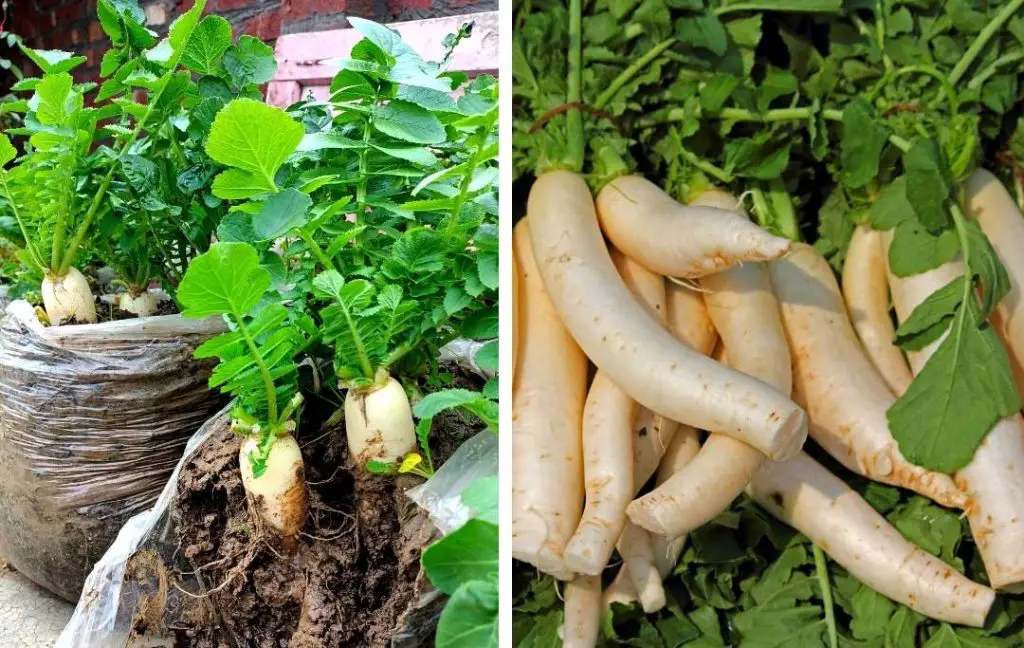
The size of this variety of radish is large and long. The size of Deccan reddish can be 2 feet long with 3 inches diameter just like a large carrot with leafy tops.
The flavor of daikon radish is sweet and crispy with pepper flavor. You should not be late for harvesting because their pepper flavor will become spicy and intense. If you are late in picking the dragons then they will become woody like other types of radish.
Can Daikon Radish Grow In Containers?
If you are facing the problem of limited space but want to grow daikon radish. Then a container is an ideal solution to this problem. Daikon radish can also grow well in containers and you will enjoy tasty green tops and crispy fresh daikon radish.
As the size of the daikon radish is large, you should use a wide container. The depth of the container must be at least 15 inches. But a deeper container is better for growing daikon radish.
The reason is that a deep container provides extra room for this root vegetable. The other important thing about the container is the drainage holes. Your container must have drainage holes at the bottom.
Most of the plants don’t like wet feet and without drainage, your plant can become the victim of root rot. Waterlogging is a serious problem and can destroy your dragon radish plants.
When To Plant Daikon Radishes In A Container?
You should choose the best time for growing daikon radish so you will get a successful crop. Spring is the best time like other plants to start planting daikon seeds.
When the temperature is 5 degrees centigrade or 40 degrees Fahrenheit then it is the best time for sowing the seeds. daikon is a winter vegetable and can tolerate lower temperatures but hard frost is the enemy of this plant.
Within 50 days you will see the crop is ready for harvest. As you are growing daikons in containers or pots then you can easily start your daikon seeds early. You can grow daikon till early summer and again sow the seeds in late summer to early winter.
How To Sow Daikon Radishes Seeds?
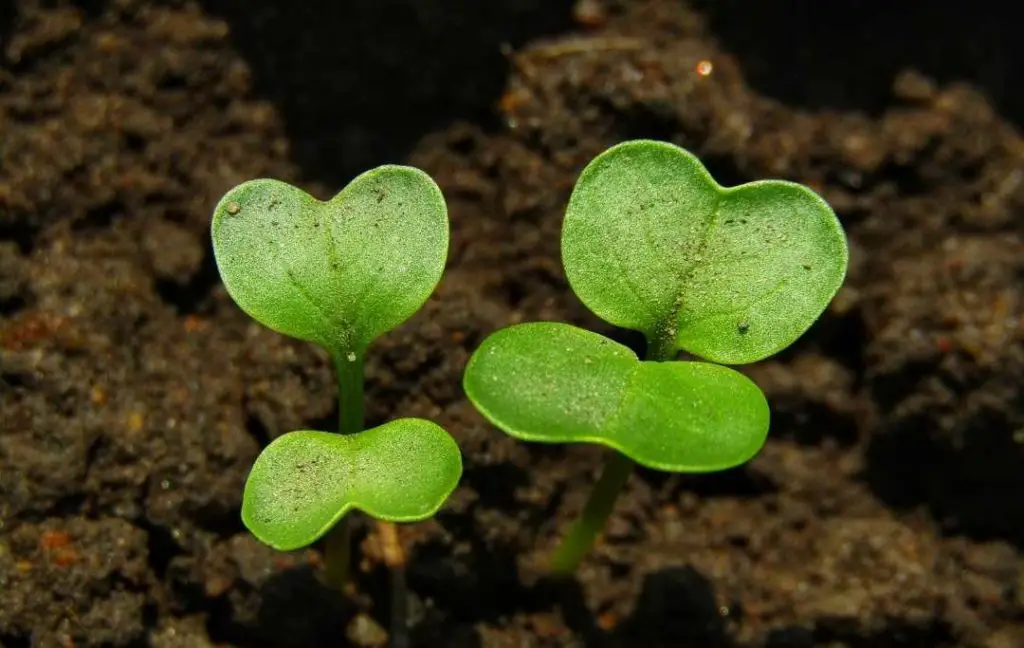
As you are growing daikon radishes in a container, it is better to sow the seeds directly in the soil. You should avoid using c trace for preparing the seedlings and so the seeds directly in the desired containers.
This is the most common way of propagating the daikon radish. After preparing your container, you can sow the seeds according to your growing zone.
The best time for sowing the seeds is 2 months before the first frost date. The daikon plants can’t tolerate frost so you should sow the seeds on time to get a mature crop.
Make ¼ to ½ inches holes in the soil of the container. Now sow the seeds at a distance of 12 to 18 inches. In this way, your daikon radish roots enough space to develop.
After placing the seeds in the holes, cover them with a potting mix. After 3 to 10 days you will see the seeds will start germinating. The tiny plants will start emerging from the soil in the container.
How To Grow Daikon Radishes?
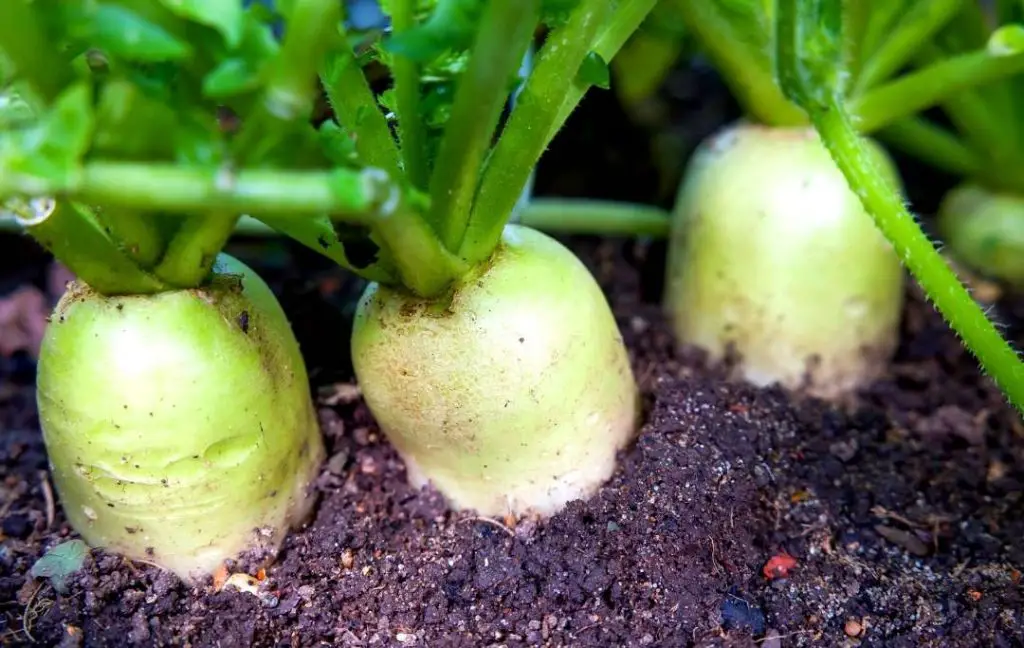
- Make sure you are using rich soil for growing daikon radish roots.
- The soil should be loosened before sowing the seeds. In this way, the roots of daikon radish will get enough space for development.
- Keep the soil moist after sowing the seeds in the container.
- Within a few days, you will see the seeds will start germinating. The moisture in the soil will speed up the germination process. After germination, you should thin the seedlings. There should be a gap of 4 to 6 inches between each seedling to provide enough space for the development of the roots.
- After 40 to 70 days you will see your crop will be ready to harvest. The duration of maturity depends upon the variety you are using for growing in the containers. During the development of roots, your soil should be moist, not wet; this will damage the edible roots.
- When you are applying fertilizer then make sure there should be less amount of nitrogen in it. As nitrogen will help to grow more foliage than roots.
Requirements For Growing Daikons
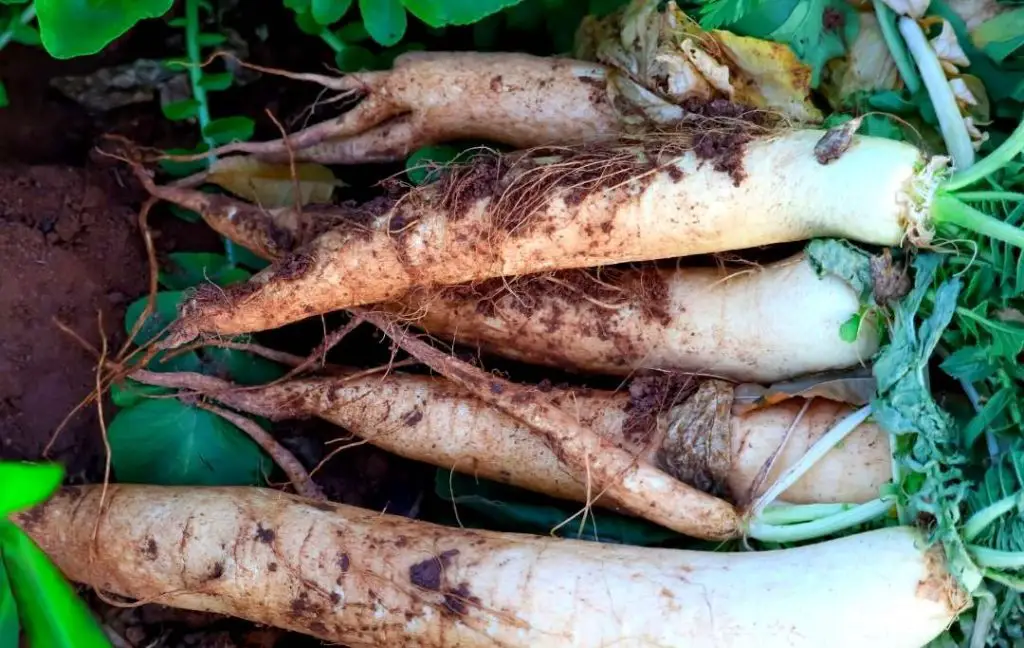
You will not face any trouble growing daikon radish in containers. For growing daikon, you don’t need any experience, with little know-how you can be successful in growing super healthy daikon radish.
SOIL
Healthy soil is the key to growing healthy plants. You should fill your container or pot with high-quality potting mix. Potting mix has all the essential nutrients to make your daikon radishes more nutritious.
You should avoid using garden soil to fill the container for growing the daikon radish. When you grow plants in the container then you can maintain the fertility of the soil according to the requirement of the plants. It is not possible when you grow plants in the ground of your garden.
With the help of a fork, you can loosen the soil. The soil aeration is very important for the daikon roots as they cannot grow in compact soil. Avoid using too much nitrogen when you grow daikon roots as nitrogen helps to grow foliage bigger rather than roots.
SUNLIGHT
Light is an important factor in the growth of any plant. For winter variety, light conditions are less important; they can grow well from full sun to partial shade. You should choose a sunny location for your container where they get phone sun exposure because less light will not grow big roots.
WATER
Daikon radish needs plenty of water for the better development of roots but you should avoid overwatering. Overwatering can become the reason for many diseases and pests.
In the same way, underwatering will give your plant more stress and it will produce irregular and small roots. If you are living in a dry climate or such a region with less rainfall you can water daikon plants once a week.
For rainy areas, well-drained soil is essential for your containers. It will prevent your plants from being damaged. It is better to check the soil with the help of the finger if it feels dry then you can water your plants.
TEMPERATURE
Daikon radish likes to grow in a cold environment. The best temperature should be between 40 to 95 Fahrenheit or 5 to 35 degrees centigrade.
The germination process of seeds will become slow if the seeds of daikon radish will not get the required temperature. The best flavor of daikon will be between 50 to 70 degrees Fahrenheit.
FERTILIZER
It is recommended that you can add slow-release fertilizer at the time of planting. You can also make 1/3 part of compost or aged manure instead of fertilizer.
You should use such fertilizer that contains low nitrogen such as 5-10-10. When the daikon radish is 2 weeks old then you can apply water-soluble fertilizer for good results.
Keep Reading:
- 20 Easy Vegetables To Grow In Grow Tent
- 8 Fast Growing Vegetables That You Can Grow In A Hurry
- 20 Best Vegetables To Grow In Buckets
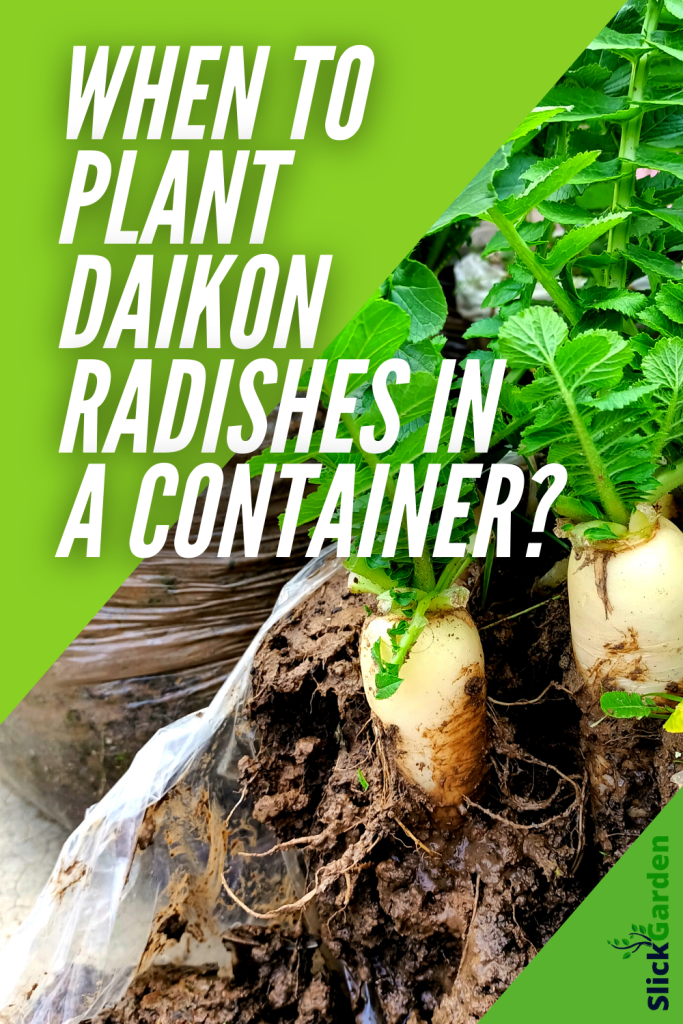
Pests And Disease
Daikon radishes are not disturbed by pests or insects but some insects are harmful to them. The following are the insects and diseases that can destroy the roots.
FLEA BEETLE
They are little bugs that can create little holes in the greens of the daikon radish. You can see these holes after close examination of the leaves. The size of the beetle is about 1/16 to 1/4 inch.
HARLEQUIN BUG
Although these bugs look so pretty, they can destroy your crop. The colors of these tiny insects are orange and black. You can see the shield-shaped bodies of these insects.
They like to eat leafy greens of daikon radish roots. So you should be careful when you see them on daikon plants. Handpick is the best way to get rid of these tiny insects. You can also use insecticidal soapy water. The other way of using neem oil.
CABBAGE MAGGOT
Cabbage maggots are also harmful to your daikon radish roots.
SEPTORIA LEAF SPOT
Yellow sports with grey centers on the leaves of Deccan is the clear symptom that your plant is affected by this fungus disease. You should remove infected leaves immediately as this is the best treatment for this problem. In this way, the fungus will stop spreading.
BLACKROOT ROT
When this fungus affects your plant then the shape of daikon radish will be distorted. If they attack young seedlings then your plant may die. The bad news is that you can’t stop this disease from spreading.
But if you follow some precautions then you can prevent your plants. For instance, avoid overwatering and use the container with drainage holes.
How To Harvest Daikon Radish?
The best time for harvesting daikon radish is when the roots grow 8 inches long. Never leave the roots in the soil, otherwise, they will become very hard just like wood.
Before harvesting, you must loosen the soil around the roots of the daikon. When the soil is loose then you can grasp the leafy green part of the daikon radish and pull it from the soil.
In this way, the Entire root comes out and you can use it. With the help of a sharp knife, you can cut the green part from the daikon radish. You can use the leafy green part of the root for stir fry, salad, and other dishes. it is better to eat the daikon root fresh.
How To Store Daikon Radishes?
If you want to store daikon radish roots then the first step is to remove the dirt from the root. avoid washing the roots before storing them. Now take a damp towel and wrap all the roots in it.
Now store them in the refrigerator. In this way, all the roots remain fresh for 3 to 4 weeks because of high humidity and cool temperature. A moist and cold environment is perfect for storing daikon radish. You can also refrigerate the green tops of the roots in a zip-top plastic bag for a few days
